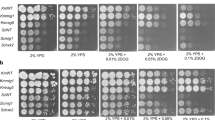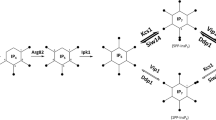Abstract
Previously we reported that mutations in the Saccharomyces cerevisiae REG1 gene encoding a negative regulator of glucose-repressible genes, suppress the RNA processing defects and temperature-sensitive growth of rna1-1 and prp cells. This result and the fact that growth on non-glucose carbon sources also suppresses rna1-1 led us to propose that RNA processing and export of RNA from the nucleus are responsive to carbon source regulation. To understand how carbon source affects these processes, we used p70, an antigen regulated by REGI and by glucose availability, as a reporter. We found that the response of p70 to glucose availability is mediated by both the SNFI-SSN6-dependent glucose repression and the RAS-cAMP pathways. These results led us to test whether the RAS-cAMP pathway interacts with RNA1. We found that suppression of rnal-1 appears to be mediated, at least in part, by the RAS-cAMP pathway.
Similar content being viewed by others
References
Amberg DC, Goldstein AL, Cole CN (1992) Isolation and characterization of RAT1: an essential gene of Saccharomyces cerevisiae required for the efficient nucleocytoplasmic trafficking of mRNA. Genes Dev 6:1173–1189
Birnboim HC, Doly J (1979) A rapid alkaline extraction procedure for screening recombinant plasmid DNA. Nucleic Acids Res 7:1513–1523
Broach JR, Deschenes RJ (1990) The function of RAS genes in Saccharomyces cerevisiae. Adv Cancer Res 54:79–139
Carlson M, Osmond BC, Botstein D (1981) Mutants of yeast defective in sucrose utilization. Genetics 98:25–40
Carlson M, Osmond BC, Neigeborn L, Botstein D (1984) A suppressor of snf1 mutations causes constitutive high-level invertase synthesis in yeast. Genetics 107:19–32
Celenza JL, Carlson M (1986) A yeast gene that is essential for release from glucose repression encodes a protein kinase. Science 233:1175–1180
Dombek KM, Camier S, Young ET (1993) ADH2 expression is repressed by REG1 independently of mutations that alter the phosphorylation of the yeast transcription factor ADR1. Mol Cell Biol 13:4391–4399
Forrester W, Stutz F, Rosbash M, Wickens M (1992) Defects in mRNA 3′-end formation, transcription initiation, and mRNA transport associated with the yeast mutation prp20: possible coupling of mRNA processing and chromatin structure. Genes Dev. 6:1914–1926
Goldstein A, Lampen JO (1975) β-D-Fructofuranoside fructohydrolase from yeast. Methods Enzymol 42C:504–511
Hopper AK, Banks F, Evangelidis V (1978) A yeast mutant which accumulates precursor tRNAs. Cell 14:211–219
Hopper AK, Traglia HM, Dunst RW (1990) The yeast RNA1 gene product necessary for RNA processing is located in the cytosol and apparently excluded from the nucleus. J Cell Biol 111:309–321
Hubbard EJA, Yang X, Carlson M (1992) Relationship of the cAMP-dependent protein kinase pathway to the SNF1 protein kinase and invertase expression in Saccharomyces cerevisiae. Genetics 130:71–80
Hutchison HT, Hartwell LH, McLaughlin CS (1969) Temperature-sensitive yeast mutant defective in ribonucleic acid production. J Bacteriol 99:807–814
Ito H, Fukuda Y, Murata K, Kimura A (1983) Transformation of intact yeast cells treated with alkali cations. J Bacteriol 153:163–168
Johnston M, Carlson M (1992) Regulation of carbon and phosphate utilization. In: Jones EW, Pringle JR, Broach JR (eds) The molecular biology of the yeast Saccharomyces: gene expression. Cold Spring Harbor Laboratory Press, Cold Spring Harbor, New York, pp 193–281
Keleher CA, Redd MJ, Schultz J, Carlson M, Johnson AD (1992) Ssn6-Tupl is a general repressor of transcription in yeast. Cell 68:709–719
Knapp G, Beckmann JS, Johnson PF, Fuhrman SA, Abelson J (1978) Transcription and processing of intervening sequences in yeast tRNA genes. Cell 14:221–236
Maddock J-R, Weidenhammer EM, Adams CC, Lunz RL, Woolford JL Jr (1994) Extragenic suppressors of Saccharomyces cerevisiae prp4 mutations identify a negative regulator of PRP genes. Genetics 136:833–847
Maniatis T, Fritsch EF, Sambrook J (1982) Molecular cloning: a laboratory manual. Cold Spring Harbor Laboratory Press, Cold Spring Harbor, New York
Mermoud JE, Cohen P, Lamond AI (1992) Scr/Thr-specific protein phosphatases are required for both catalytic steps of pre-mRNA splicing. Nucleic Acids Res 20:5263–5269
Mortimer R, Hawthorne D (1969) Yeast genetics. In: Rose AH, Harrison JS (eds) The yeasts, vol 1. Academic Press, New York, pp 385–460
Neigeborn L, Carlson M (1987) Mutations causing constitutive invertase synthesis in yeast: genetic interactions with snf mutations. Genetics 115:247–253
Niederacher D, Entian K-D (1987) Isolation and characterization of the regulatory HEX2 gene necessary for glucose repression in yeast. Mol Gen Genet 206:505–509
Niederacher D, Entian KD (1991) Characterization of Hex2 protein, a negative regulatory element necessary for glucose repression in yeast. Eur J Biochem 200:311–319
Nolan SL (1989) Analysis of a suppressor of the yeast mutation rnal-1. PhD thesis, Pennsylvania State University, Hershey, USA
Pearson, NJ, Thorburn PC, Haber JE (1982) A suppressor of temperature-sensitive rna mutations that affect mRNA metabolism in Saccharomyces cerevisiae. Mol Cell Biol 2:571–577
Peterson GL (1977) A simplification of the protein assay method of Lowry et al. which is more generally applicable. Anal Biochem 83:346–356
Robinson MR, van Zyl WH, Phizicky EM, Broach JR (1994) TPD1 of S. cerevisiae encodes a protein phosphatase 2C-like activity implicated in tRNA splicing and cell separation. Mol Cell Biol 14:3634–3645
Rothstein RJ (1983) One-step gene disruption in yeast. Methods Enzymol 101:202–211
Rymond BC, Rosbash M (1992). Yeast pre-mRNA splicing. In: Jones EW, Pringle JR, Broach JR (eds) The molecular biology of the yeast Saccharomyces: gene expression. Cold Spring Harbor Laboratory Press, Cold Spring Harbor, New York, pp 143–192
Schultz J, Carlson M (1987) Molecular analysis of SSN6, a gene functionally related to the SNF1 protein kinase of Saccharomyces cerevisiae. Mol Cell Biol 7:3637–3645
Shin D-Y, Matsumoto K, Iida H, Uno I, Ishikawa T (1987) Heat shock response of Saccharomyces cerevisiae mutants altered in cyclic AMP-dependent protein phosphorylation. Mol Cell Biol 7:244–250
Shiokawa K, Pogo AO (1974) The role of cytoplasmic membranes in controlling the transport of nuclear messenger RNA and initiation of protein synthesis. Proc Natl Acad Sci USA 71:2658–2662
Tazi J, Kornstadt U, Rossi F, Jeanteur P, Cathala G, Brunel C, Lührmann R (1993) Thiophosphorylation of Ul-70K protein inhibits pre-mRNA splicing. Nature 363:283–286
Thompson-Jaeger S, Francois J, Gaughran JP, Tatchell K (1991) Deletion of SNF1 affects the nutrient response of yeast and resembles mutations which activate the adenylate cyclase pathway. Genetics 129:697–706
Trumbly RJ (1986) Isolation of Saccharomyces cerevisiae mutants constitutive for invertase synthesis. J Bacteriol 166:1123–1127
Trumbly RJ (1992) Glucose repression in yeast Saccharomyces cerevisiae. Mol Microbiol 6:15–21
Tung, K-S, Norbeck LL, Nolan SL, Atkinson NS, Hopper AK (1992) SRN1, a yeast gene involved in RNA processing, is identical to HEX2/REG1, a negative regulator in glucose repression. Mol Cell Biol 12:2673–2680
Turcq B, Dobinson KF, Serizawa N, Lambowitz AM (1992) A protein required for RNA processing and splicing in Nettrospora mitochondria is related to gene products involved in cell cycle protein phosphatase functions. Proc Natl Acad Sci USA 89:1676–1680
van Zyl WH, Wills N, Broach JR (1989) A general screen for mutants of Saccharomyces cerevisiae deficient in tRNA biosynthesis. Genetics 123:55–68
Author information
Authors and Affiliations
Additional information
Communicated by C. P. Hollenberg
Rights and permissions
About this article
Cite this article
Tung, KS., Hopper, A.K. The glucose repression and RAS-cAMP signal transduction pathways of Saccharomyces cerevisiae each affect RNA processing and the synthesis of a reporter protein. Molec. Gen. Genet. 247, 48–54 (1995). https://doi.org/10.1007/BF00425820
Received:
Accepted:
Published:
Issue Date:
DOI: https://doi.org/10.1007/BF00425820




